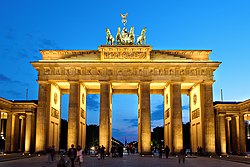
Back Brandenburgse Poort AF Puerta de Brandemburgo AN بوابة براندنبورغ Arabic Puerta de Brandeburgu AST Brandenburq qapısı AZ Бранденбург ҡапҡаһы BA Kori Brandenburg BAN Брандэнбургскія вароты BE Брандэнбурская брама BE-X-OLD Бранденбургска врата Bulgarian
| Brandenburg Gate | |
|---|---|
Brandenburger Tor | |
 View from the Pariser Platz on the east side | |
 | |
| General information | |
| Type | City gate |
| Architectural style | Neoclassical |
| Location | Berlin, Germany |
| Coordinates | 52°30′59″N 13°22′40″E / 52.5163°N 13.3777°E |
| Construction started | 1788 |
| Completed | 1791 |
| Design and construction | |
| Architect(s) | Carl Gotthard Langhans |
The Brandenburg Gate (German: Brandenburger Tor [ˈbʁandn̩ˌbʊʁɡɐ ˈtoːɐ̯] ⓘ) is an 18th-century neoclassical monument in Berlin. One of the best-known landmarks of Germany, it was erected on the site of a former city gate that marked the start of the road from Berlin to Brandenburg an der Havel, the former capital of the Margraviate of Brandenburg. The current structure was built from 1788 to 1791 by orders of King Frederick William II of Prussia, based on designs by the royal architect Carl Gotthard Langhans. The bronze sculpture of the quadriga crowning the gate is a work by the sculptor Johann Gottfried Schadow.
The Brandenburg Gate is located in the western part of the city centre within Mitte, at the junction of Unter den Linden and Ebertstraße. The gate dominates the Pariser Platz to the east, while to the immediate west it opens onto the Platz des 18. März beyond which the Straße des 17. Juni begins. One block to the north stands the Reichstag building, home to the German parliament (Bundestag), and further to the west is the Tiergarten inner-city park. The gate also forms the monumental entry to Unter den Linden, which leads directly to the former City Palace of the Prussian monarchs (now housing the Humboldt Forum museum), and Berlin Cathedral.
Throughout its existence, the Brandenburg Gate was often a site for major historical events. After World War II and during the Cold War, until its fall in 1989, the gateway was obstructed by the Berlin Wall, and was for almost three decades a marker of the city's division. Since German reunification in 1990, it has been considered not only a symbol of the tumultuous histories of Germany and Europe, but also of European unity and peace.[1]
- ^ "Brandenburg Gate". berlin.de. Retrieved 3 August 2021.